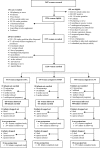Small-quantity, lipid-based nutrient supplements provided to women during pregnancy and 6 mo postpartum and to their infants from 6 mo of age increase the mean attained length of 18-mo-old children in semi-urban Ghana: a randomized controlled trial
- PMID: 27534634
- PMCID: PMC4997301
- DOI: 10.3945/ajcn.116.134692
Small-quantity, lipid-based nutrient supplements provided to women during pregnancy and 6 mo postpartum and to their infants from 6 mo of age increase the mean attained length of 18-mo-old children in semi-urban Ghana: a randomized controlled trial
Abstract
Background: Childhood stunting usually begins in utero and continues after birth; therefore, its reduction must involve actions across different stages of early life.
Objective: We evaluated the efficacy of small-quantity, lipid-based nutrient supplements (SQ-LNSs) provided during pregnancy, lactation, and infancy on attained size by 18 mo of age.
Design: In this partially double-blind, individually randomized trial, 1320 women at ≤20 wk of gestation received standard iron and folic acid (IFA group), multiple micronutrients (MMN group), or SQ-LNS (LNS group) daily until delivery, and then placebo, MMNs, or SQ-LNS, respectively, for 6 mo postpartum; infants in the LNS group received SQ-LNS formulated for infants from 6 to 18 mo of age (endline). The primary outcome was child length by 18 mo of age.
Results: At endline, data were available for 85% of 1228 infants enrolled; overall mean length and length-for-age z score (LAZ) were 79.3 cm and -0.83, respectively, and 12% of the children were stunted (LAZ <-2). In analysis based on the intended treatment, mean ± SD length and LAZ for the LNS group (79.7 ± 2.9 cm and -0.69 ± 1.01, respectively) were significantly greater than for the IFA (79.1 ± 2.9 cm and -0.87 ± 0.99) and MMN (79.1 ± 2.9 cm and -0.91 ± 1.01) groups (P = 0.006 and P = 0.009, respectively). Differences were also significant for weight and weight-for-age z score but not head or midupper arm circumference, and the prevalence of stunting in the LNS group was 8.9%, compared with 13.7% in the IFA group and 12.9% in the MMN group (P = 0.12). In analysis based on actual supplement provided at enrollment, stunting prevalences were 8.9% compared with 15.1% and 11.5%, respectively (P = 0.045).
Conclusion: Provision of SQ-LNSs to women from pregnancy to 6 mo postpartum and to their infants from 6 to 18 mo of age may increase the child's attained length by age 18 mo in similar settings. This trial was registered at clinicaltrials.gov as NCT00970866.
Keywords: child growth; home fortification; lipid-based nutrient supplements; multiple micronutrients; supplementation.
Figures


References
-
- Adair LS, Fall CH, Osmond C, Stein AD, Martorell R, Ramirez-Zea M, Sachdev HS, Dahly DL, Bas I, Norris SA, et al. . Associations of linear growth and relative weight gain during early life with adult health and human capital in countries of low and middle income: findings from five birth cohort studies. Lancet 2013;382:525–34. - PMC - PubMed
-
- Black RE, Victora CG, Walker SP, Bhutta ZA, Christian P, de Onis M, Ezzati M, Grantham-McGregor S, Katz J, Martorell R, et al. . Maternal and child undernutrition and overweight in low-income and middle-income countries. Lancet 2013;382:427–51. - PubMed
-
- Olofin I, McDonald CM, Ezzati M, Flaxman S, Black RE, Fawzi WW, Caulfield LE, Danaei G; Nutrition Impact Model Study . Associations of suboptimal growth with all-cause and cause-specific mortality in children under five years: a pooled analysis of ten prospective studies. PLoS One 2013;8:e64636. - PMC - PubMed
Publication types
MeSH terms
Substances
Associated data
LinkOut - more resources
Full Text Sources
Other Literature Sources
Medical

